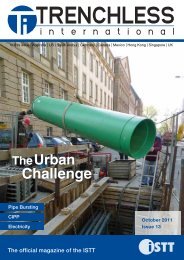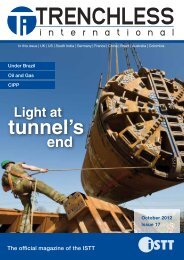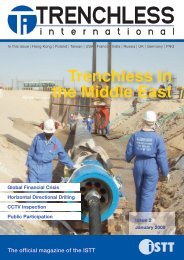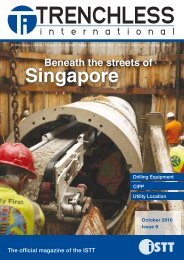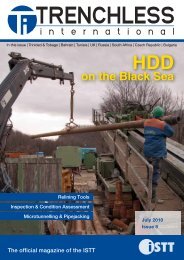North American Special - Trenchless International
North American Special - Trenchless International
North American Special - Trenchless International
You also want an ePaper? Increase the reach of your titles
YUMPU automatically turns print PDFs into web optimized ePapers that Google loves.
news<br />
April 2009 - <strong>Trenchless</strong> <strong>International</strong><br />
News in Brief<br />
English privates go public<br />
Approximately 200,000 km of privately<br />
owned sewers and lateral drains in<br />
England will be transferred to water and<br />
sewerage companies from 2011.<br />
Currently, if a private sewer or lateral<br />
drain needs repairing, the bill is picked<br />
up by householders, even if the problem<br />
is outside their property boundary.<br />
Most householders don’t even know the<br />
sewer or drain is their responsibility as it<br />
is not apparent when buying a property,<br />
and their insurance policies are unlikely<br />
to cover wear and tear.<br />
Environment Secretary Hilary Benn<br />
said “Millions of householders are unwittingly<br />
sitting on the ticking financial<br />
time bomb of private sewers and lateral<br />
drains. They may not realise it, but if<br />
something goes wrong they have to pick<br />
up the bill. The transfer to water and<br />
sewerage companies will create a fairer<br />
system for all and save many households<br />
the agony of finding thousands of<br />
pounds to pay for repairs.”<br />
It is estimated that well over half<br />
of all houses in England have a private<br />
sewer or lateral drain, the part of<br />
a drain that lies outside the property<br />
boundary. An extensive review of private<br />
sewers began in 2001, prompted<br />
by the concerns of householders and<br />
a consultation in 2003 revealed a high<br />
level of support for transfer. The costs<br />
of transfer will be met by an increase in<br />
the sewerage element of bills across the<br />
nine sewerage companies currently<br />
estimated to be around 7.5 pence to 23<br />
pence a week.<br />
Before the transfer can take place, the<br />
government has to introduce and consult<br />
on regulations and follow Parliamentary<br />
process. The water and sewage companies<br />
will then have to draw up schemes<br />
for the transfer of private sewers in their<br />
regions.<br />
Private sewers stem from an arrangement<br />
that dates from 1936, before that<br />
time the 1875 Public Health Act had<br />
made all sewers public. The 1936 Public<br />
Health Act meant sewers were only public<br />
if they were already in place, laid or<br />
adopted by a sewerage undertaker.<br />
B.C. – new life for old pipes<br />
The City of Victoria in British Columbia,<br />
Canada has begun rehabilitating an integral<br />
part of the city’s water transmission<br />
system, renewing 4,500 metres of highpressure<br />
steel pipes, ranging in diameter<br />
from 20 cm – 1 metre.<br />
The $US4.4 million pipe contract has<br />
been awarded to Insituform Technologies.<br />
The company will complete the work in 26<br />
installations, using a close-fit polyethylene<br />
solution for water pipe renewal. Work began<br />
in late November 2008 and is expected to<br />
be completed in August 2009.<br />
The City of Victoria has a history of promoting<br />
environmentally sound practices. In<br />
addition to Insituform’s minimally disruptive<br />
and environmentally friendly method of<br />
rehabilitating transmission mains, the city<br />
has also retained a professional arborist to<br />
help protect the trees on the job site.<br />
Robbins receives medal for TBM<br />
Development<br />
In April 2009, Richard J. Robbins,<br />
President and CEO of The Robbins<br />
Company from 1958 to 1993, will accept the<br />
Benjamin Franklin Medal for Engineering.<br />
Mr Robbins is being honoured for a lifetime<br />
of innovation underground — developing<br />
TBMs for some of the largest tunnelling<br />
projects in history.<br />
The Franklin Institute Awards have been<br />
ongoing for 185 years, and continue to<br />
recognise the greatest men and women in<br />
science, engineering and technology. Mr<br />
Robbins said “When I reflect on the process<br />
of the award, and the fact that only<br />
one engineer is picked per year, I am truly<br />
honoured and amazed.”<br />
Mr Robbins’ father developed the first<br />
rock tunnel boring machine in 1952 and<br />
founded The Robbins Company, which<br />
is now a worldwide business with representation<br />
in over 25 countries. Richard<br />
Robbins has been responsible for leading<br />
or creating the company’s subsequent<br />
innovations, from large diameter hard rock<br />
disc cutters to the first Double Shield TBM<br />
for Italy’s Orichella Project in 1972.<br />
“One of the most memorable projects<br />
I’ve worked on is the Channel Tunnel.<br />
We designed machines that successfully<br />
bored through water-bearing ground at 10<br />
bar pressure — a much higher pressure<br />
than had ever been done before,” said Mr<br />
Robbins. The 39 km (24 mi) long Channel<br />
Tunnel was completed in 1991, following<br />
the use of five Robbins shielded TBMs<br />
placing precast concrete segments.<br />
Another career highlight was a machine<br />
developed for the RER metro system<br />
in Paris, France in 1965. “We created<br />
the world’s first below water, pressure<br />
bulkhead shielded machine using air<br />
pressure.”<br />
Richard Robbins continues to work in<br />
the tunnelling industry as a member of<br />
the Board of Directors of The Robbins<br />
Company and as a collaborator in development<br />
projects. He sees much work to<br />
be done in the future.<br />
Communicating below the surface<br />
Telecommunications company, Eastern<br />
Communications will install a 240 km fibre<br />
network to service industrial parks and<br />
economic zones in the Philippines, using<br />
HDD to minimise traffic disruptions.<br />
Eastern Communications representative<br />
Edwin Domingo said “Eastern's backhaul<br />
expansion will provide us with three<br />
business opportunities. Primarily, we will<br />
provide connectivity to more than 600 ecozones<br />
and industrial parks along the route<br />
where the backhaul will run. Secondarily,<br />
it will allow the company to maximise the<br />
submarine cables because of the additional<br />
bandwidth, and thirdly, it will allow us<br />
to offer greater bandwidth to other carriers<br />
and telecommunications companies.”<br />
Multinational corporations and BPOs are<br />
relocating to various economic zones and<br />
industrial parks located in Tagaytay, Cavite,<br />
Laguna, and Batangas. The expansion will<br />
also reach Nasugbu, enabling the company<br />
to connect to its submarine cables.<br />
Surprises lead to delays, delays lead to cost<br />
overruns. So work with a team that keeps nasty<br />
surprises away from you, your schedule, and<br />
your budget. At Mears, our in-house planners<br />
and engineers look deeper, to plan farther<br />
ahead. And, our field operators have both<br />
<strong>Trenchless</strong> success in the Middle East<br />
<strong>Trenchless</strong> Middle East 2009, held<br />
in Dubai’s Jumeirah Beach Conference<br />
and Exhibition Centre, has been heralded<br />
as a success by the ISTT and<br />
conference delegates.<br />
<strong>Trenchless</strong> Middle East, the fifth event<br />
in this biennial series, was complemented<br />
by the ISTT Masterclass, which<br />
attracted 40 participants from several<br />
Middle Eastern countries including the<br />
UAE, Saudi Arabia, and Oman, as well<br />
as attendees from Russia, Bulgaria and<br />
the United Kingdom.<br />
ISTT Executive Secretary John<br />
Hemphill said “The Masterclass format<br />
seems ideal for getting the message on<br />
<strong>Trenchless</strong> Technology to regions of the<br />
world where we have no affiliated societies<br />
and to affiliated societies that have a<br />
need for trenchless training but may not<br />
be in a position to host an ISTT No-Dig.”<br />
The conference provided an opportunity<br />
for specialist companies from around<br />
the world to display their equipment<br />
and services for the installation, repair<br />
and refurbishments of utility companies,<br />
engineers, consultants, planners, and<br />
traffic authorities.<br />
GSTT Executive Director, Dr Klaus Beyer; John Hemphill, show-organiser<br />
Caroline Prescott of Westrade, GSTT Chairman Professor Jens Hölterhoff and<br />
Dr Dec Downey at the German Pavillion at <strong>Trenchless</strong> Middle East.<br />
Mears horizontal directional drilling. Because a lot can<br />
happen between Point A and Point B.<br />
the expertise and the equipment to implement<br />
any plan, in any place.<br />
We listen. We plan. We deliver. So the only<br />
thing that happens, is success. Give us a call<br />
at (800) 632-7727.<br />
DESIGN/BUILD • SOIL AND ROCK • SMALL TO LARGE CROSSINGS • SHORE APPROACHES<br />
Mears Group, Inc. • 411 <strong>North</strong> Sam Houston Parkway East, Suite 420 • Houston, TX 77060 USA • www.mears.net<br />
news<br />
April 2009 - <strong>Trenchless</strong> <strong>International</strong><br />
10<br />
11






